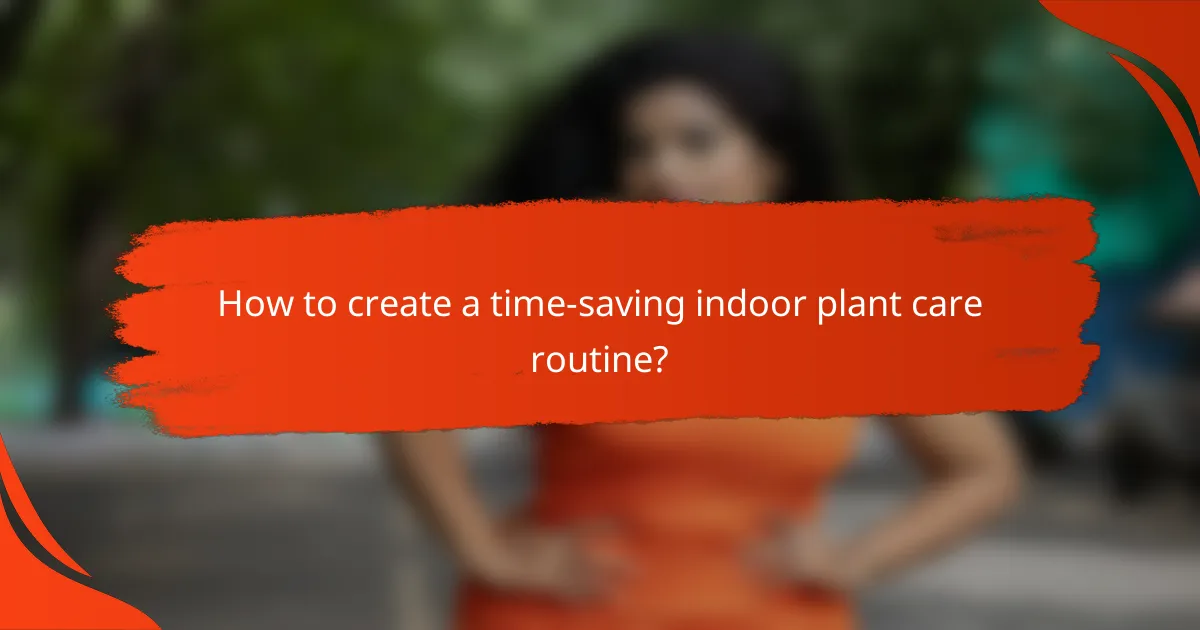For busy professionals, caring for indoor plants can be both rewarding and manageable with the right approach. By choosing low-maintenance varieties and implementing efficient care strategies, you can enjoy the beauty of greenery in your space without a significant time commitment. Establishing a consistent routine and utilizing helpful tools will make plant care a seamless part of your lifestyle.

How can busy professionals care for indoor plants?
Busy professionals can care for indoor plants by selecting low-maintenance varieties and utilizing tools that simplify watering and maintenance. By implementing time-saving strategies, they can enjoy the benefits of greenery without a significant time commitment.
Low-maintenance plant options
Choosing low-maintenance plants is crucial for busy individuals. Consider options like snake plants, pothos, or ZZ plants, which thrive in various lighting conditions and require minimal watering. These plants can tolerate neglect, making them ideal for those with hectic schedules.
When selecting plants, look for those that are resilient and adaptable. Many succulents and cacti also fall into this category, needing only occasional watering and bright light. This allows busy professionals to enjoy greenery without constant attention.
Automated watering systems
Automated watering systems can significantly ease the burden of plant care. These systems can be programmed to deliver water at specific intervals, ensuring plants receive consistent moisture without manual effort. Options range from simple drip irrigation setups to more advanced smart systems that monitor soil moisture levels.
When considering an automated system, assess your plant’s needs and the size of your indoor garden. A basic system may cost around $30 to $100, while more sophisticated models can go up to several hundred dollars. Investing in automation can save time and reduce the risk of over or under-watering.
Self-watering pots
Self-watering pots are another practical solution for busy professionals. These pots feature a reservoir that allows plants to absorb water as needed, reducing the frequency of watering. They are particularly beneficial for plants that prefer consistent moisture levels.
When using self-watering pots, ensure the reservoir is filled regularly and check for any blockages that could impede water flow. This method can help maintain healthy plants with minimal effort, making it easier to manage indoor greenery.
Plant subscription services
Plant subscription services offer a convenient way for busy professionals to expand their indoor plant collection without the hassle of shopping. These services deliver curated plants directly to your door, often accompanied by care instructions tailored to each species.
Subscriptions typically range from $10 to $50 per month, depending on the number and type of plants. This option not only saves time but also introduces variety and excitement to your indoor garden, making plant care a more enjoyable experience.

What are the best indoor plants for low light?
The best indoor plants for low light are those that thrive in minimal sunlight, making them ideal for busy professionals who may not have time for extensive plant care. These plants typically require less frequent watering and can adapt to various indoor environments.
Snake plant
Snake plants, also known as Sansevieria, are highly resilient and can survive in low light conditions. They have tall, upright leaves that can tolerate neglect, making them perfect for busy individuals.
To care for a snake plant, water it sparingly, allowing the soil to dry out completely between waterings. This plant can thrive in a range of temperatures, ideally between 15°C and 30°C, and does well in various potting mixes.
Pothos
Pothos, or Epipremnum aureum, is another excellent choice for low light environments. Its trailing vines can grow long and lush, adding a decorative touch to any space.
This plant prefers to dry out slightly between waterings and can adapt to different light conditions, although it thrives best in indirect light. Regular pruning can help maintain its shape and encourage bushier growth.
ZZ plant
The ZZ plant, or Zamioculcas zamiifolia, is known for its glossy leaves and ability to thrive in low light. It is exceptionally drought-tolerant, making it suitable for those who may forget to water regularly.
To care for a ZZ plant, place it in a well-draining pot and water it only when the soil is completely dry. It can tolerate a range of temperatures but prefers warmth, ideally between 18°C and 24°C.

How to create a time-saving indoor plant care routine?
To create a time-saving indoor plant care routine, prioritize tasks and establish a consistent schedule. Focus on grouping similar plants and utilizing technology to streamline care processes.
Weekly care schedules
Establishing a weekly care schedule helps ensure that your plants receive the attention they need without overwhelming your time. Dedicate specific days for watering, fertilizing, and checking for pests. For example, you might water on Mondays, fertilize on Wednesdays, and inspect for issues on Fridays.
Consider using a simple checklist to track your tasks. This can be as straightforward as a note on your phone or a printed chart on your wall. Regularly reviewing your schedule can help you stay on top of plant care without needing to remember every detail.
Grouping plants by needs
Grouping plants by their care requirements can significantly reduce the time spent on maintenance. For instance, place all your tropical plants together, as they typically require similar humidity and light conditions. This allows you to water and mist them at the same time.
Additionally, consider separating low-maintenance plants from those that need more attention. This way, you can quickly identify which plants require immediate care and which can be left for a later time.
Using plant care apps
Plant care apps can be invaluable for busy professionals looking to streamline their indoor gardening efforts. Many apps allow you to set reminders for watering, fertilizing, and other tasks, ensuring you never miss a care opportunity.
Some popular options include PlantSnap and Blossom, which provide care tips tailored to specific plant species. By leveraging technology, you can save time and reduce the risk of neglecting your plants.

What are the essential tools for indoor plant care?
Essential tools for indoor plant care include items that help monitor moisture, maintain plant health, and provide nutrients. Having the right tools can streamline your plant care routine, making it easier for busy professionals to keep their greenery thriving.
Moisture meter
A moisture meter is a valuable tool that helps you determine when to water your plants. It measures the moisture level in the soil, allowing you to avoid overwatering or underwatering, which can harm your plants. Most moisture meters are easy to use; simply insert the probe into the soil and read the level on the display.
When selecting a moisture meter, consider models that offer a clear scale, typically ranging from dry to wet. Some advanced models may also include features like pH measurement, which can further aid in plant care.
Pruning shears
Pruning shears are essential for maintaining the health and appearance of your indoor plants. Regular pruning helps remove dead or yellowing leaves, promotes new growth, and can prevent pests and diseases. Choose a pair of sharp, ergonomic shears to make the task easier and more efficient.
When using pruning shears, aim to cut at a 45-degree angle just above a leaf node. This technique encourages healthy growth and minimizes damage to the plant. Always clean your shears before and after use to prevent the spread of disease.
Fertilizer options
Fertilizers provide essential nutrients that indoor plants need to thrive. There are various options available, including liquid, granular, and slow-release fertilizers. Liquid fertilizers are typically fast-acting and can be mixed with water for easy application, while granular options release nutrients slowly over time.
When choosing a fertilizer, look for a balanced formula with equal parts nitrogen, phosphorus, and potassium, often labeled as N-P-K. For most indoor plants, fertilizing every four to six weeks during the growing season is recommended. Always follow the manufacturer’s instructions to avoid over-fertilization, which can harm your plants.

How to choose the right soil for indoor plants?
Choosing the right soil for indoor plants is crucial for their health and growth. Look for a mix that provides good drainage, aeration, and nutrient retention, tailored to the specific needs of your plants.
Potting mix types
There are several types of potting mixes available, each designed for different plant needs. Common types include all-purpose mixes, cactus and succulent mixes, and orchid mixes. Each blend contains varying components that affect moisture retention and drainage.
All-purpose potting mixes are versatile and suitable for most houseplants, while cactus and succulent mixes are designed with sand and perlite for excellent drainage. Orchid mixes typically contain bark and other materials to allow airflow around the roots.
When selecting a potting mix, consider the specific requirements of your plants. For instance, if you have tropical plants, opt for a mix that retains moisture, whereas succulents thrive in drier conditions. Always check the label for specific use recommendations to avoid common pitfalls.


